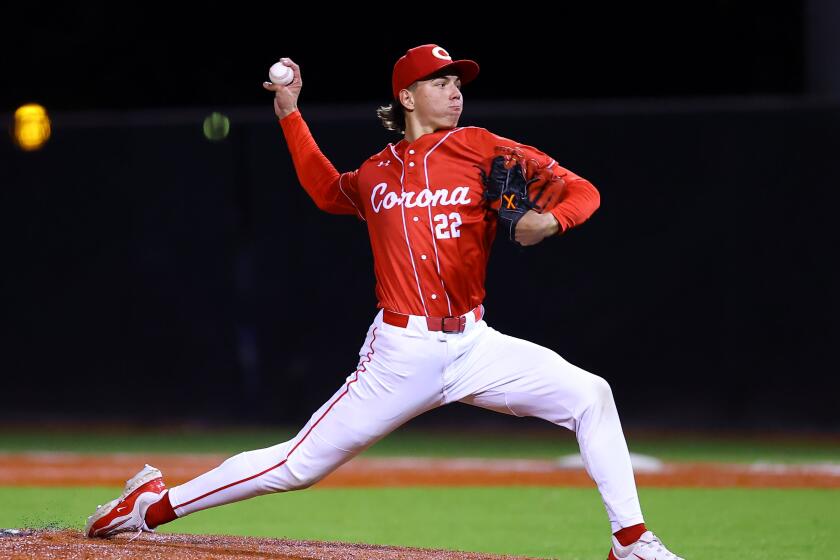Former Padre Ace Randy Jones Changes Suits but Still Has a Good Pitch
- Share via
His uniform is now a three-piece suit. Scouting reports on opposing batters have been replaced by cash-flow charts and production sheets.
But even as Randy Jones discusses his job as president of RJP & Associates, Inc., he manages to slip those baseball analogies into the conversation.
“This stuff is a little more complicated than throwing a slider to Pete Rose,” said Jones, the former Cy Young award-winning pitcher for the San Diego Padres and New York Mets.
“I like the diversification of my business, and I have the right players in the right positions. I’ve dedicated myself to my company, just like I did in baseball. I used to pitch every fourth day, but now I pitch every day.”
Jones, with his former Chapman College Coach Paul Deese as a partner, started a marketing investment firm in 1983 and has offices in San Diego and San Juan Capistrano. The RJP stands for Randy Jones and Paul.
“Pretty fancy, eh?” said Jones, who lives in Poway.
Jones, 35, has dabbled in real estate, with a $1.1 million commercial, office and restaurant project near Chico, and in alternative energy sources, marketing windmills for a Northern California firm. He also owns a percentage of the Las Vegas Americans indoor soccer team.
But for a few hours tonight, when he is inducted into the Orange County Hall of Fame, Jones will be swept back about a decade to his glory years with the Padres--when he went 20-12 in 1975 and 22-14 in 1976. The latter performance earned him honors as the National League’s best pitcher.
He said his acceptance speech tonight in the Anaheim Convention Center will be just like the games he pitched--short and to the point.
After that, it will be back to work on Tuesday.
Back to the real world.
But don’t let those business suits fool you. There’s still plenty of baseball left in the good ol’ boy from Brea.
It’s the camaraderie in the clubhouse--the daily ribbing between his teammates and the practical jokes--that Jones misses the most about the summer game.
In his 10 years with the Padres and Mets, Jones was quite the prankster. He may not be able to fill his own version of “Ball Four,” but there were a few doozies.
One of his favorites was a trick he’d regularly play on reliever Rollie Fingers. On get-away days, when the team had to catch a flight shortly after a game, Jones would tie knots in Fingers’ dress pants.
“He’d always be the last out of the shower, and when he’d try to put his pants on, he’d fall,” said Jones, the curly mopped blond. “That was always fun.”
And along with the pranks came the paybacks. Revenge was a big part of the game.
Once in 1979, Fingers wadded a bunch of newspapers, threw them in Jones’ cubicle and lit his locker on fire. Teammates doused the flames with a combination of sand and water.
“I had these crispy critters all over my uniforms,” Jones recalled. “That was a beauty.”
Jones had just as much fun on the field.
With what Pete Rose called “a 27-mile per hour fastball,” Jones used to frustrate and baffle batters. He rarely walked anyone, and he rarely struck anyone out. His specialty was the double-play ball.
The left-hander got the job done with a sinker and slider, neither of which traveled much faster than a high school pitcher’s changeup. They accused him of throwing a spitter, but he said he never needed one.
If he did, heck, the ball would have been dry by the time it reached the plate.
Jones worked quickly on the mound, and when he was in the groove, he could mesmerize an opponent. He once pitched a complete game in 1 hour and 29 minutes.
When his game was on, batters would continually pound Jones’ pitches into the ground and then pound their helmets into the dugout wall. The more frustrated they got, the more fun Jones had.
“Pete Rose got the most upset,” Jones said. “I got him out so much that he would come by the mound and yell at me. I’d just get off the mound and grin, because I had him so frustrated that he couldn’t hit me.”
Philadelphia’s Mike Schmidt was another victim. Jones once struck him out in Veterans Stadium, and Schmidt nearly tore up the dugout with his bat.
“He was yelling, ‘Go warm up! Lift weights! Anything!’ “Jones said. “A lot of guys used to yell at me, and that was what I wanted. It meant I was getting to them. If anyone was frustrated, that was a compliment.”
Jones, a graduate of Brea-Olinda High School, was San Diego’s first baseball hero.
Attendance would bulge in San Diego Stadium on the nights Jones pitched. He recalled one game in June 1976 when more than 40,000 fans came out on a Wednesday night, about 30,000 more than the average week-night crowd, to watch Jones and the Padres shut out the Mets and Tom Seaver, 3-0.
He had a 16-3 record by the All-Star break, made the cover of Sports Illustrated and started for the National League in the 1976 All-Star game. Many speculated that he would win 30 games, but he tailed off in the second half.
Still, Jones was a celebrity. People would wave to him on the freeway. Every time he went out to eat, it was an autograph session.
“I took the kids (Jami and Staci) and my wife (Marie) to see the Ice Capades at the San Diego Sports Arena, and I held up the show for 10 minutes because there was a line of about 100 people wanting autographs,” Jones said. “Finally, I had to tell them to sit down.
“The fans were really wrapped up in what I was doing. There were big crowds and standing ovations. I got an opportunity to share the year with thousands of fans in San Diego, and it was really unique.”
To Jones, this was pure enjoyment. It sure beat going 8-22, which was what he did in 1974.
But in 1975, at the urging of then-Padre pitching coach Tom Morgan, Jones altered his windup and made a slight change in his mechanics.
“He (Morgan) almost turned me into a machine,” Jones said.
Suddenly, Jones was able to hit spots more consistently. He was using more body and less arm and wasn’t tiring as much in the later innings. And his confidence grew.
“The first guy might line a single past me to open the game, but the next pitch was a ground ball to shortstop, and there were two outs, nobody on,” Jones said. “I expected that, and I made it happen.”
Jones threw hard in high school but soreness and tendinitis took the zip out of his fastball. By 1973, he adopted his new pitching style under minor league coach Warren Hacker, who taught him the sinker.
Playing for the Padres’ AA affiliate in Alexandria, La., Jones won his first eight decisions in 1973 and was promoted to the big-league roster on June 1. He had an inauspicious debut.
The first major-league hit he allowed was a home run to Willie Mays in Shea Stadium. He returned to San Diego, where Atlanta’s Hank Aaron greeted him with a three-run homer.
“I got everyone out of the way in a hurry,” Jones said.
He earned his first win in his third start, a complete-game, 4-2 victory over the Dodgers.
Said Jones: “After I got a taste of winning, I loved it.”
Maybe too much.
Jones pitched every fourth day, and 300 innings a season was the norm. But at the end of 1976, with his arm beginning to drag, all those sliders caught up with him.
He snapped the main nerve in his left arm in his last start and re-injured it early in 1977. He missed the rest of the ’77 season and came back to have productive years in ’78 and ’79 until he damaged the nerve again in 1980.
The Padres dealt Jones to the Mets during the winter of 1980, but he had little success. He went 1-8 in 1981, started out 6-2 in ’82 but finished 7-10 after hurting his arm again.
The Mets gave him his unconditional release in 1982, but Jones had one more fling, this time with the Pittsburgh Pirates, during spring training 1983.
“That was just a six-week vacation and home,” Jones said.
Jones is still under contract with the Mets and will be paid through 1986. The income allowed him to venture into business without fear of failure during the early years.
“God bless guaranteed contracts,” he said.
Jones finished with a 100-123 lifetime record, not quite good enough to be honored in Cooperstown some day. But his only regret is that he never played on a winner.
“But I’m not the only guy who has gone through a career without winning,” he said. “What would have happened if I didn’t hurt my arm? I don’t know, nor do I worry about it. This (business) is a whole new ballgame, and it has just as much pressure.
“And I have to learn all the hitters.”
More to Read
Go beyond the scoreboard
Get the latest on L.A.'s teams in the daily Sports Report newsletter.
You may occasionally receive promotional content from the Los Angeles Times.











